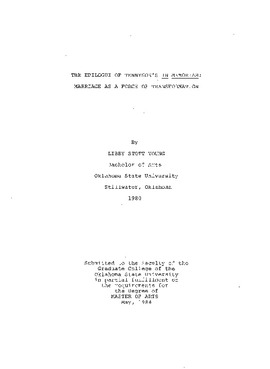| dc.contributor.advisor | Milstead, John | |
| dc.contributor.author | Young, Libby Stott | |
| dc.date.accessioned | 2015-08-21T20:37:35Z | |
| dc.date.available | 2015-08-21T20:37:35Z | |
| dc.date.issued | 1984-05-01 | |
| dc.identifier.uri | https://hdl.handle.net/11244/16143 | |
| dc.description.abstract | This study examines the imagery, scientific metaphor, and literary conventions that Alferd Tennyson uses in the Epilogue of In Memoriam, particularly those concering the power of marital love. The study discusses the aspects of disorder and order, death and life, and degeneracy and progress. It explores the connection of love with the force that transforms negative images into positive ones. The findings of the study are that Tennyson incorporates several literacy conventions to convey that love can indeed transform disorder, death and degeneracy into order, life, and progress. Tennyson draws upon paga, Judeo-Christrian, and Renaissance literature. Scientific metaphor suports the power of love, and the images of the Epilogue incorporate and transform the images of the elegy. | |
| dc.format | application/pdf | |
| dc.language | en_US | |
| dc.publisher | Oklahoma State University | |
| dc.rights | Copyright is held by the author who has granted the Oklahoma State University Library the non-exclusive right to share this material in its institutional repository. Contact Digital Library Services at lib-dls@okstate.edu or 405-744-9161 for the permission policy on the use, reproduction or distribution of this material. | |
| dc.title | Epilogue of Tennyson's In Memoriam: Marriage as a Force of Transformation | |
| dc.type | text | |
| dc.contributor.committeeMember | Luecke, Jane Marie | |
| dc.contributor.committeeMember | Klemp, Paul | |
| osu.filename | Thesis-1984-Y73e.pdf | |
| osu.accesstype | Open Access | |
| dc.description.department | English | |
| dc.type.genre | Thesis | |
